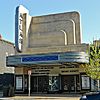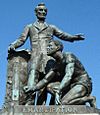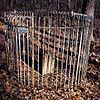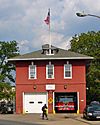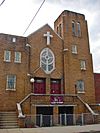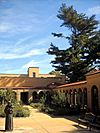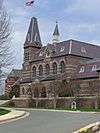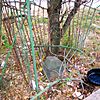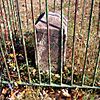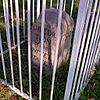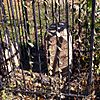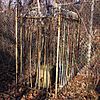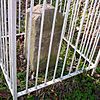National Register of Historic Places listings in Northeast Quadrant, Washington, D.C. facts for kids
This is a list of properties and districts in the Northeast quadrant of Washington, D.C. that are listed on the National Register of Historic Places.
Current listings
| Name on the Register | Image | Date listed | Location | City or town | Description | |
|---|---|---|---|---|---|---|
| 1 | American Revolution Statuary |
(#78000256) |
Public buildings and various parks within DC 38°53′37″N 76°59′59″W / 38.893611°N 76.999722°W |
Stanton Park | 14 statues including 11 in central DC, and the General Nathanael Greene statue in Stanton Park | |
| 2 | Atlas Theater and Shops |
(#10000909) |
1313-33 H Street, NE 38°53′59″N 76°59′15″W / 38.899722°N 76.9875°W |
Near Northeast | ||
| 3 | Mountjoy Bayly House |
(#73002072) |
122 Maryland Ave., NE 38°53′29″N 77°00′18″W / 38.891389°N 77.005°W |
Capitol Hill | ||
| 4 | Brookland Bowling Alleys |
(#100004306) |
3726 10th St. NE. 38°56′10″N 76°59′36″W / 38.9362°N 76.9933°W |
Brookland | ||
| 5 | Brooks Mansion |
(#75002045) |
901 Newton St., NE. 38°55′58″N 76°59′37″W / 38.932778°N 76.993611°W |
Brookland | ||
| 6 | Ralph Bunche House |
(#93001013) |
1510 Jackson St., NE. 38°55′47″N 76°59′02″W / 38.929722°N 76.983889°W |
Brookland | ||
| 7 | Bunker Hill Elementary School |
(#14000186) |
1401 Michigan Ave., NE 38°56′31″N 76°59′06″W / 38.942004°N 76.984969°W |
Brookland | ||
| 8 | Capitol Hill Historic District |
(#76002127) |
Roughly bounded by Virginia Ave., SE., S. Capitol St., F St., NE., and 14th Sts., SE. and NE.; also roughly bounded by 7th St., NE., I-295, M St., SE., and 11th St., SE. 38°53′13″N 76°59′51″W / 38.886944°N 76.9975°W |
NE, SE and NW | Second set of boundaries represents a boundary increase of July 3, 2003 | |
| 9 | Chesapeake and Potomac Telephone Company Warehouse and Repair Facility |
(#06001159) |
1111 N. Capitol St. NE 38°54′15″N 77°00′32″W / 38.9043°N 77.009°W |
NE | ||
| 10 | Children's Country Home |
(#03001254) |
1731 Bunker Hill Rd. NE 38°56′29″N 76°58′39″W / 38.941389°N 76.9775°W |
Woodridge | ||
| 11 | Civil War Fort Sites |
(#74000274) |
Arc of sites surrounding central Washington in Maryland, Virginia, and D.C. 38°56′08″N 76°59′15″W / 38.935509°N 76.987628°W |
All quadrants | At the outset of the Civil War in 1861, Washington became a critical target for rebel attacks but was virtually without protection. The Union Army hastily began construction of a fortified defense line around the city, the physical remnants of which encompass these 19 earthwork forts, including Fort Totten, Fort Bunker Hill, Fort Lincoln, and Fort Mahan. See also National Register listings in central D.C., western NW D.C., upper NW D.C., SE D.C., Prince George's County, Maryland, and Fairfax County, Virginia. | |
| 12 | Civil War Monuments in Washington, DC |
(#78000257) |
Various parks within the original boundaries of city 38°53′23″N 76°59′25″W / 38.889722°N 76.990278°W |
Various | 18 statues about people and topics related to the Civil War, including 1 in Lincoln Park (NE & SE quadrants), 6 in the upper NW quadrant, and 11 in central Washington. | |
| 13 | Alexander Crummell School |
(#03000671) |
Kendall and Gallaudet Sts, NE 38°54′48″N 76°59′07″W / 38.913333°N 76.985278°W |
NE | ||
| 14 | Dahlgreen Courts |
(#10000901) |
2504-2520 10th St., NE 38°55′22″N 76°59′34″W / 38.922778°N 76.992778°W |
Brookland | Apartment Buildings in Washington, DC, MPS | |
| 15 | East Capitol Street Carbarn |
(#74002158) |
1400 E. Capitol St., NE. 38°53′23″N 76°59′06″W / 38.889722°N 76.985°W |
NE | ||
| 16 | East Corner Boundary Marker of the Original District of Columbia |
(#96001249) |
100 ft. E of jct. of Eastern and Southern Aves. 38°53′35″N 76°54′34″W / 38.893056°N 76.909444°W |
NE and SE | See List of Boundary Markers of the Original District of Columbia | |
| 17 | Emerald Street Historic District |
(#100001560) |
1307-1377, 1306-1368 Emerald St. NE., 517-519 13t St. NE., 518-520 14th St. NE. 38°53′48″N 76°59′13″W / 38.896725°N 76.986907°W |
NE | ||
| 18 | Engine House No. 10 |
(#08001063) |
1341 Maryland Ave., NE 38°53′54″N 76°59′13″W / 38.898364°N 76.986866°W |
NE | ||
| 19 | Engine Company 17 |
(#07000538) |
1227 Monroe St. NE 38°55′56″N 76°59′24″W / 38.932222°N 76.990000°W |
Brookland | ||
| 20 | Engine Company 26 |
(#11000283) |
1340 Rhode Island Ave., NE 38°55′29″N 76°59′12″W / 38.924722°N 76.986667°W |
Brentwood/ Brookland | Firehouses in Washington DC MPS | |
| 21 | Engine Company 26, (Old) |
(#07000536) |
2715 22nd St. NE 38°55′30″N 76°58′27″W / 38.925°N 76.974167°W |
NE | ||
| 22 | Engine Company 27 |
(#11000284) |
4201 Minnesota Ave., NE 38°54′04″N 76°56′36″W / 38.901111°N 76.943333°W |
NE | Firehouses in Washington DC MPS | |
| 23 | First Baptist Church of Deanwood |
(#08000720) |
1008 45th St. NE 38°54′11″N 76°56′17″W / 38.903119°N 76.938°W |
Deanwood | ||
| 24 | Franciscan Monastery and Memorial Church of the Holy Land |
(#91001943) |
1400 Quincy St., NE. 38°56′13″N 76°59′00″W / 38.936944°N 76.983333°W |
Brookland | ||
| 25 | Gallaudet College Historic District |
(#66000856) |
Florida Ave. and 7th St., NE. 38°54′22″N 76°59′45″W / 38.906111°N 76.995833°W |
NE | ||
| 26 | Glenwood Cemetery |
(#16000638) |
2219 Lincoln Rd., NE 38°55′18″N 77°00′20″W / 38.921651°N 77.005488°W |
NE | ||
| 27 | Glenwood Cemetery Mortuary Chapel |
(#88003064) |
2219 Lincoln Rd., NE 38°55′19″N 77°00′22″W / 38.921944°N 77.006111°W |
NE | ||
| 28 | Harewood Lodge |
(#100003672) |
3600 Harewood Rd. NE. 38°55′57″N 77°00′05″W / 38.9326°N 77.0014°W |
NE | ||
| 29 | Hecht Company Warehouse |
(#94000446) |
1401 New York Ave., NE. 38°54′52″N 76°59′06″W / 38.914444°N 76.985°W |
NE | ||
| 30 | Holy Redeemer College |
(#100003958) |
3112 Seventh St. NE 38°55′44″N 76°59′48″W / 38.9288°N 76.9967°W |
NE | ||
| 31 | Kenilworth Aquatic Gardens |
(#78000258) |
Kenilworth Ave. and Douglas St. NE 38°54′46″N 76°56′37″W / 38.912778°N 76.943611°W |
NE | ||
| 32 | Kingman Park Historic District |
(#100002960) |
Between Rosedale & D St., Maryland Ave. NE, 19th St. & Oklahoma Ave. NE 38°53′44″N 76°58′28″W / 38.8956°N 76.974494°W |
Kingman Park | ||
| 33 | Langston Golf Course Historic District |
(#91001525) |
Roughly, Anacostia Park N of Benning Rd. NE 38°54′08″N 76°57′54″W / 38.902222°N 76.965°W |
NE | ||
| 34 | Langston Terrace Dwellings |
(#87001851) |
N from Benning Rd. to H St., NE 38°53′58″N 76°58′26″W / 38.899444°N 76.973889°W |
Langston | ||
| 35 | The Lexington |
(#15000978) |
1114 F St., NE 38°53′51″N 76°59′28″W / 38.897570°N 76.991040°W |
Near Northeast | ||
| 36 | Mayfair Mansions Apartments |
(#89001735) |
3819 Jay St., NE 38°54′11″N 76°56′55″W / 38.903056°N 76.948611°W |
Mayfair | ||
| 37 | Metropolitan Apartments |
(#14000199) |
200-210 Rhode Island Ave., NE. 38°55′09″N 77°00′12″W / 38.919253°N 77.003327°W |
Edgewood | ||
| 38 | Newton Theater |
(#07000592) |
3601-3611 12th St. NE 38°56′08″N 76°59′27″W / 38.935556°N 76.990833°W |
Brookland | ||
| 39 | Northeast No. 3 Boundary Marker of the Original District of Columbia |
(#96001256) |
144 ft. NW of jct. of Eastern Ave. and Chillum Rd. 38°57′55″N 77°00′06″W / 38.965271°N 77.001750°W |
NE | ||
| 40 | Northeast No. 4 Boundary Marker of the Original District of Columbia |
(#96001255) |
5400 Sargent Rd. 38°57′17″N 76°59′17″W / 38.954722°N 76.988056°W |
NE | ||
| 41 | Northeast No. 5 Boundary Marker of the Original District of Columbia |
(#96001254) |
4609 Eastern Ave. 38°56′39″N 76°58′28″W / 38.9442°N 76.9744°W |
NE | ||
| 42 | Northeast No. 6 Boundary Marker of the Original District of Columbia |
(#96001253) |
3601 Eastern Ave. 38°56′01″N 76°57′41″W / 38.9336°N 76.9614°W |
NE | ||
| 43 | Northeast No. 7 Boundary Marker of the Original District of Columbia |
(#96001252) |
Ft. Lincoln Cemetery 38°55′26″N 76°56′56″W / 38.9239°N 76.9489°W |
NE | ||
| 44 | Northeast No. 8 Boundary Marker of the Original District of Columbia |
(#96001251) |
Kenilworth Aquatics Gardens, NW of jct. of Eastern and Kenilworth Aves. 38°54′50″N 76°56′10″W / 38.9139°N 76.9361°W |
NE | ||
| 45 | Northeast No. 9 Boundary Marker of the Original District of Columbia |
(#96001250) |
919 Eastern Ave. 38°54′12″N 76°55′21″W / 38.9033°N 76.9225°W |
NE | ||
| 46 | Plymouth Theater |
(#04000117) |
1365 H St., NE 38°54′07″N 76°59′11″W / 38.9019°N 76.9864°W |
NE | ||
| 47 | President's House, Gallaudet College |
(#74002172) |
7th St. and Florida Ave., NE. 38°54′19″N 76°59′46″W / 38.9053°N 76.9961°W |
NE | ||
| 48 | Roosevelt Apartment Building |
(#94001045) |
1116-1118 F St., NE. 38°53′50″N 76°59′27″W / 38.8972°N 76.9908°W |
Near Northeast | ||
| 49 | St. Paul's College |
(#100002913) |
3015 4th St. NE. 38°55′41″N 76°59′56″W / 38.928°N 76.9988°W |
NE | ||
| 50 | Sewall–Belmont House National Historic Site |
(#72001432) |
144 Constitution Ave., NE. 38°53′32″N 77°00′14″W / 38.8922°N 77.0039°W |
NE | ||
| 51 | Slowe-Burrill House |
(#100005324) |
1256 Kearny St. NE. 38°55′51″N 76°59′20″W / 38.9307°N 76.9890°W |
Brookland | ||
| 52 | Spingarn Senior High School |
(#14000198) |
2500 Benning Rd., NE. 38°53′58″N 76°58′15″W / 38.8995°N 76.9709°W |
Carver Langston | ||
| 53 | Strand Theater |
(#08001093) |
5129-5131 Nannie Helen Burroughs Ave., NE 38°53′54″N 76°55′34″W / 38.8983°N 76.9261°W |
NE | ||
| 54 | Trades Hall of National Training School for Women and Girls |
(#91002049) |
601 50th St., NE. 38°53′46″N 76°55′48″W / 38.8961°N 76.93°W |
NE | ||
| 55 | Truck House No. 13 |
(#07000535) |
1342 Florida Ave. NE 38°54′05″N 76°59′13″W / 38.9014°N 76.9869°W |
NE | ||
| 56 | U.S. National Arboretum |
(#73002122) |
24th and R Sts., NE. 38°54′42″N 76°57′58″W / 38.9117°N 76.9661°W |
NE | ||
| 57 | U.S. Post Office Department Mail Equipment Shops |
(#16000435) |
2135 5th St., NE 38°55′08″N 76°59′58″W / 38.9190°N 76.9995°W |
Eckington | ||
| 58 | Uline Ice Company Plant and Arena Complex |
(#07000448) |
1132, 1140, and 1146 3rd St. NE 38°54′18″N 77°00′11″W / 38.905°N 77.0031°W |
Near Northeast | ||
| 59 | Union Market Historic District |
(#100000596) |
Between 4th and 5th Sts. NE., and Florida Ave. and Penn St., NE. 38°54′30″N 76°59′57″W / 38.9083°N 76.9992°W |
NE | ||
| 60 | Union Station |
(#69000302) |
Intersection of Massachusetts and Louisiana Aves. and 1st St., NE. 38°53′51″N 77°00′23″W / 38.8975°N 77.0064°W |
NE | ||
| 61 | Union Station Plaza and Columbus Fountain |
(#80004523) |
1st St., Massachusetts and Louisiana Aves., NE 38°53′47″N 77°00′23″W / 38.8964°N 77.0064°W |
NE | ||
| 62 | United Brick Corporation Brick Complex |
(#78003061) |
2801 New York Ave., NE. 38°54′58″N 76°58′06″W / 38.9161°N 76.9683°W |
NE | ||
| 63 | Woodward & Lothrop Service Warehouse |
(#05000046) |
131 M St. NE 38°54′25″N 77°00′17″W / 38.9069°N 77.0047°W |
Near Northeast | ||
| 64 | Young, Browne, Phelps and Spingarn Educational Campus Historic District |
(#15000743) |
2500 Benning Rd., NE., 704, 820, & 850 26th St., NE 38°54′00″N 76°58′15″W / 38.9001°N 76.9708°W |
NE |

All content from Kiddle encyclopedia articles (including the article images and facts) can be freely used under Attribution-ShareAlike license, unless stated otherwise. Cite this article:
National Register of Historic Places listings in Northeast Quadrant, Washington, D.C. Facts for Kids. Kiddle Encyclopedia.


